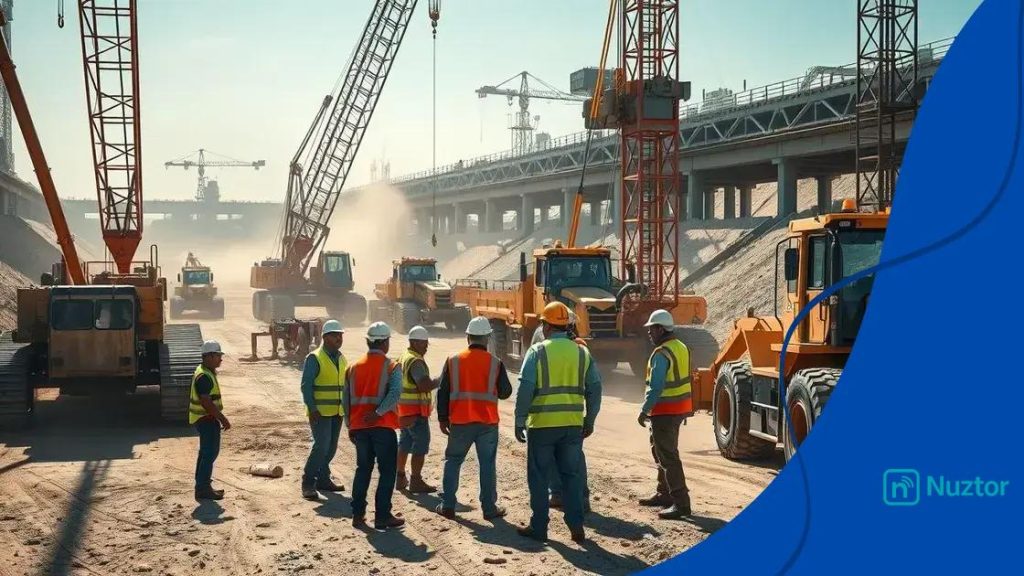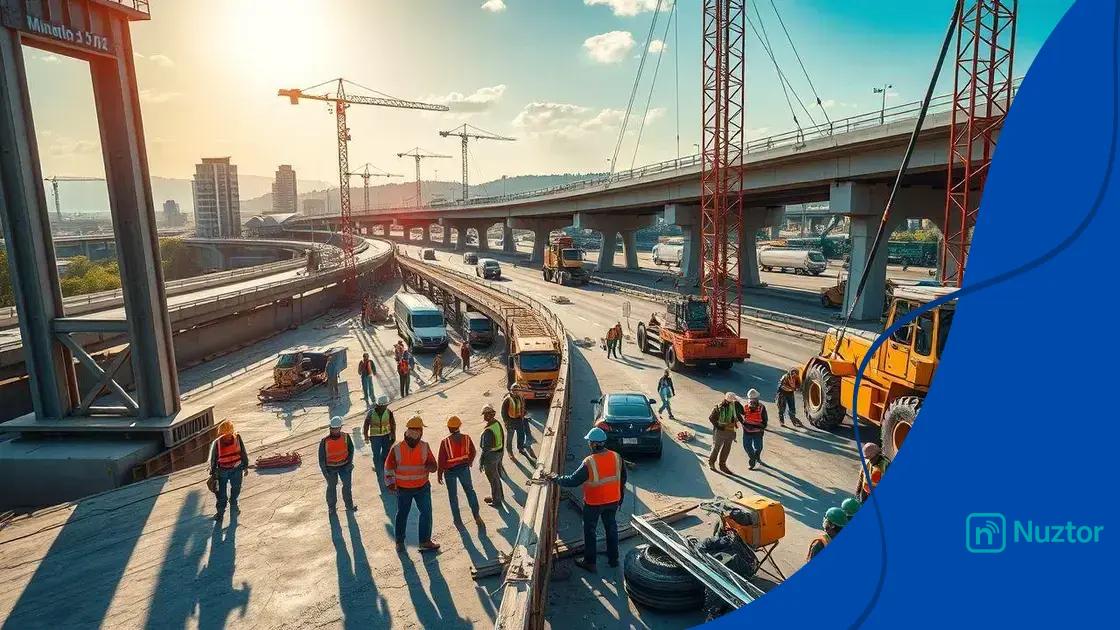Key projects from the infrastructure bill driving change

The infrastructure bill drives key projects that enhance transportation, promote sustainability, create jobs, and improve community quality of life through strategic investments in modern infrastructure.
Key projects from the infrastructure bill are set to transform the way we live and work. Have you ever considered how these initiatives will touch your daily life? Let’s dive into what these projects entail.
Overview of the infrastructure bill
The infrastructure bill is a significant piece of legislation aimed at modernizing the nation’s roads, bridges, and transportation systems. It plays a crucial role in addressing the aging infrastructure while also promoting sustainability.
These investments are expected to create millions of jobs and stimulate economic growth. The scope of the bill covers various sectors, including transportation, broadband, and energy. Each of these areas aims to improve overall quality of life and facilitate economic development.
Key Areas Addressed in the Bill
The infrastructure bill targets several key areas, ensuring comprehensive improvements across the board.
- Transportation: Enhancements to roads, transit systems, and rail networks will reduce congestion and travel times.
- Broadband Access: Funding is allocated to expand internet access in rural and underserved areas, promoting connectivity.
- Clean Energy: Investments in renewable energy sources support a sustainable future and reduce carbon emissions.
- Water Infrastructure: Upgrades to water systems aim to provide safe drinking water and improve wastewater management.
It is noteworthy how the bill’s provisions are designed to adapt to changing needs and priorities. For instance, the focus on enhancing green technology reflects the growing importance of environmental sustainability in infrastructure development. This adjustment not only caters to current demands but also prepares us for future challenges.
Moreover, engaging local communities in planning efforts ensures that projects are tailored to meet specific regional needs. By considering various voices and perspectives, the bill promotes inclusivity in infrastructure planning.
As these projects begin to roll out, the anticipated benefits will ripple through communities across the nation. By prioritizing effective and sustainable infrastructure, the bill aims to create a more resilient economy.
Major projects funded by the bill
The infrastructure bill promises to fund several major projects that will significantly enhance our transportation, energy, and communication systems. These projects aim to improve daily life and stimulate economic growth across the country.
One of the standout initiatives is the expansion of public transit systems. By modernizing these systems, communities can benefit from improved access to jobs and education. This is essential for urban areas grappling with congestion and pollution. Through increased funding, cities can upgrade their buses and trains, making them more reliable and efficient.
Key Projects Highlighted in the Bill
Among the significant projects outlined in the bill are:
- Highway Repairs: Substantial funds are designated for repairing deteriorating highways, which will enhance safety and travel times.
- Bridge Replacements: The bill allocates money to replace or repair hundreds of bridges identified as structurally deficient, ensuring safer passage.
- Broadband Expansion: Investment in expanding broadband access will provide high-speed internet to underserved rural communities, fostering digital inclusion.
- Renewable Energy Projects: Funding is committed to develop renewable energy sources such as solar and wind, promoting sustainability and reducing reliance on fossil fuels.
Additional projects include enhancing water infrastructure to ensure clean drinking water for all. Upgrades to water treatment plants and pipelines are crucial for protecting public health and the environment.
Moreover, developing smart technology within new infrastructure is a growing priority. For example, smart traffic lights can reduce congestion and improve safety, while sensor-equipped roads can monitor wear and alert maintenance crews.
As these projects unfold, the anticipated investment will generate thousands of jobs and boost local economies. Each project not only serves an immediate need but also contributes to a long-term vision for an improved infrastructure landscape.
Economic impacts of infrastructure projects

The economic impacts of infrastructure projects are profound and wide-ranging. When the government invests in infrastructure, it creates a ripple effect across various sectors of the economy. Improved infrastructure can lead to job creation, increased productivity, and enhanced quality of life.
One immediate benefit is job creation. Construction projects, from roads to bridges, require a substantial workforce. This demand for labor helps to reduce unemployment rates and provides high-paying jobs for many skilled workers.
Benefits of Infrastructure Investments
Investing in infrastructure leads to several key benefits:
- Increased Accessibility: Enhanced roads and public transit make it easier for people to access jobs, education, and healthcare.
- Boosted Business Growth: Reliable infrastructure attracts businesses, encouraging economic development in local communities.
- Improved Quality of Life: Better transportation and utilities lead to safer living environments and improved public health.
- Long-Term Savings: Investing in modern infrastructure can reduce maintenance costs over time, saving taxpayers money.
Additionally, infrastructure projects can stimulate local economies by increasing property values. Improved roads and public services often make neighborhoods more desirable, leading to rising real estate prices. This increase in property values can boost the local tax base, providing municipalities with additional resources to invest in community services.
Moreover, infrastructure improvements are essential for supporting sustainability. Projects focusing on renewable energy not only contribute to reducing carbon emissions but also create new job sectors. The growing industries related to solar and wind energy rely heavily on modern infrastructure to function effectively.
In summary, the economic impacts of infrastructure projects extend beyond immediate job creation. These investments lay the foundation for future growth and development, helping communities thrive in a constantly evolving economic landscape.
Environmental considerations in project planning
When discussing environmental considerations in project planning, it is essential to recognize that infrastructure projects impact ecosystems. Careful planning can help minimize damage and promote sustainability.
Key factors include assessing the environmental effects of proposed projects. This process typically involves thorough studies and consultations with experts. By understanding potential impacts, planners can address issues proactively.
Key Environmental Factors to Consider
Here are some important environmental aspects that should be center stage during planning:
- Wildlife Protection: Projects should assess the habitats of local wildlife to avoid disruption and protect endangered species.
- Water Quality: Planning must include efforts to prevent pollution of nearby water sources during and after construction.
- Air Quality: Evaluating potential emissions helps ensure that air quality standards are met to protect community health.
- Erosion Control: Proper measures should be taken to manage erosion and sedimentation, which can harm local environments.
Another significant consideration is long-term sustainability. Infrastructure projects should aim to utilize renewable resources and sustainable materials. Implementing green technology can help reduce the carbon footprint of new developments.
Moreover, community engagement plays a vital role in planning. Involving local residents allows for better assessment of environmental needs and concerns. Public input can help shape projects that respect local ecosystems and community values.
Incorporating environmental considerations not only benefits ecosystems but can enhance the overall quality of infrastructure. Communities that prioritize sustainability often see economic advantages, including increased property values and healthier residents. Investing time and resources in this aspect of planning pays off in the long run.
Future outlook for infrastructure development
The future outlook for infrastructure development is promising as societies aim to build smarter and more sustainable environments. As we face challenges such as climate change and rapid urbanization, innovative approaches to infrastructure planning are critical.
One major trend is the integration of technology, often referred to as “smart infrastructure.” This includes using sensors and data analytics to improve the efficiency of transportation systems, reduce energy consumption, and enhance safety features.
Emerging Trends in Infrastructure Development
Several key trends are shaping the future of infrastructure:
- Green Building Practices: More projects are adopting environmentally friendly materials and practices to minimize waste and reduce carbon footprints.
- Resilient Infrastructure: Developing systems designed to withstand extreme weather events is becoming a priority, ensuring safety and functionality.
- Inclusive Design: Planners are focusing on accessibility, creating spaces that meet the needs of all community members, including those with disabilities.
- Community Engagement: Involving residents in the planning process allows for better alignment with community needs and fosters a sense of ownership.
Furthermore, renewable energy sources are being prioritized in new developments. Solar panels, wind turbines, and electric vehicle charging stations are increasingly common. These additions support sustainability goals and reduce reliance on fossil fuels.
Moreover, funding sources for infrastructure projects are diversifying. Public-private partnerships (PPPs) are gaining traction, enabling the blending of private investment with public initiatives. This collaboration can lead to more innovative solutions and efficient execution of projects.
As infrastructure continues to evolve, the focus will remain on enhancing quality of life while safeguarding the environment. By embracing technological advancements and sustainable practices, the potential for meaningful improvements in infrastructure is vast.
In summary, infrastructure development plays a vital role in shaping our communities and economies. By investing in projects that prioritize sustainability and technological innovation, we not only improve our quality of life but also protect our planet for future generations. As we look to the future, collaboration between governments, businesses, and communities will be essential to create resilient and inclusive infrastructure solutions.
FAQ – Frequently Asked Questions about Infrastructure Development
What are the key benefits of infrastructure investment?
Infrastructure investment creates jobs, boosts economic growth, and improves the quality of life in communities.
How can communities get involved in infrastructure planning?
Communities can participate through public meetings, surveys, and feedback sessions to voice their needs and preferences.
What role does technology play in future infrastructure projects?
Technology enhances efficiency and sustainability in infrastructure projects, including smart systems and renewable energy sources.
Why are environmental considerations important in infrastructure projects?
Addressing environmental considerations helps protect ecosystems, ensures compliance with regulations, and promotes long-term sustainability.